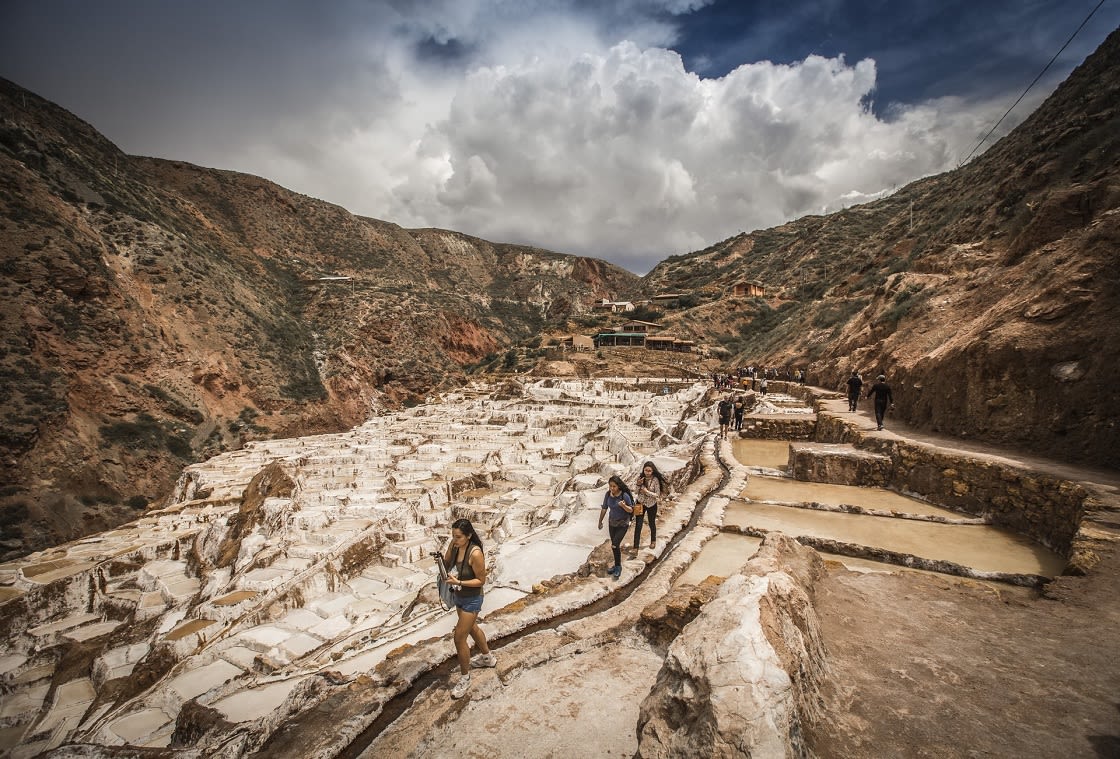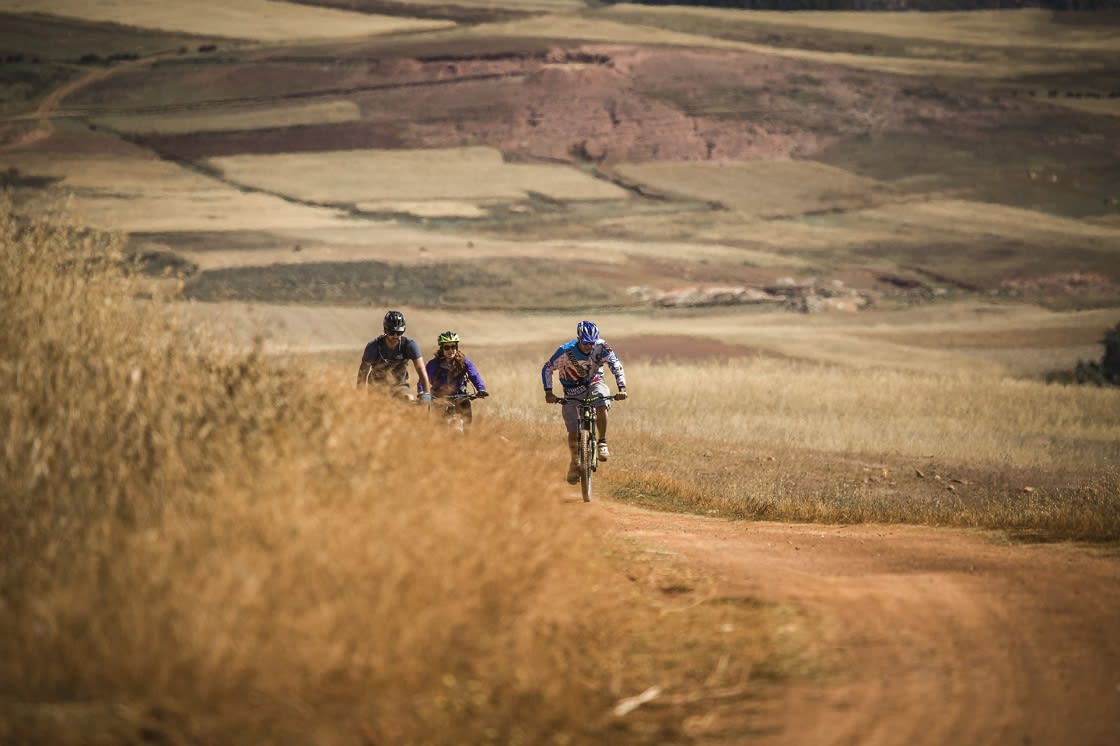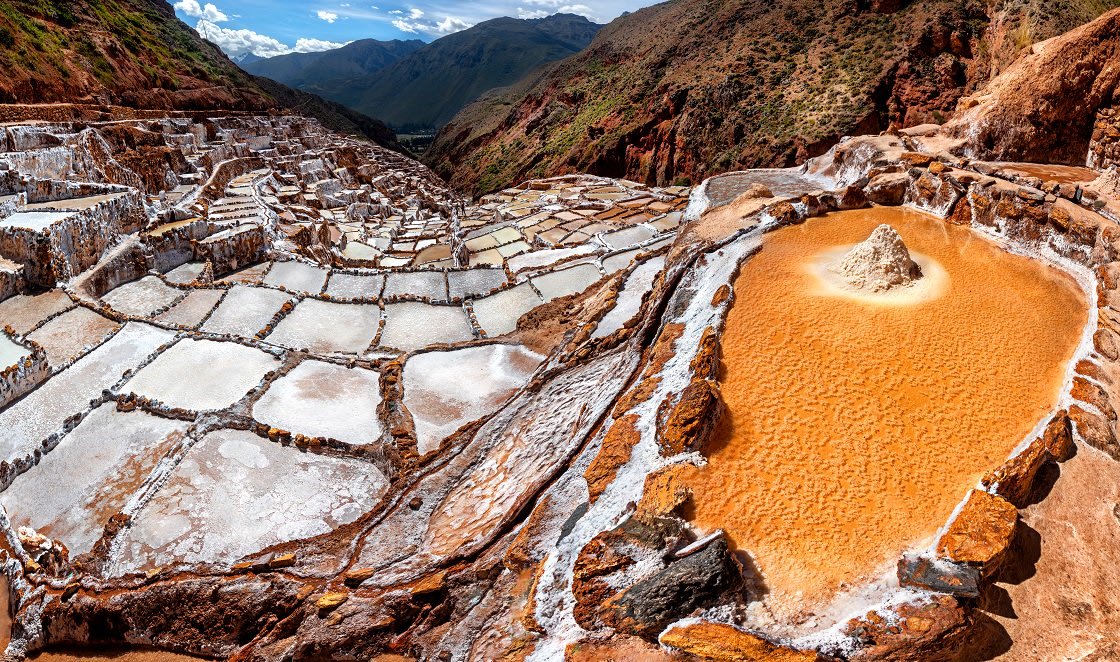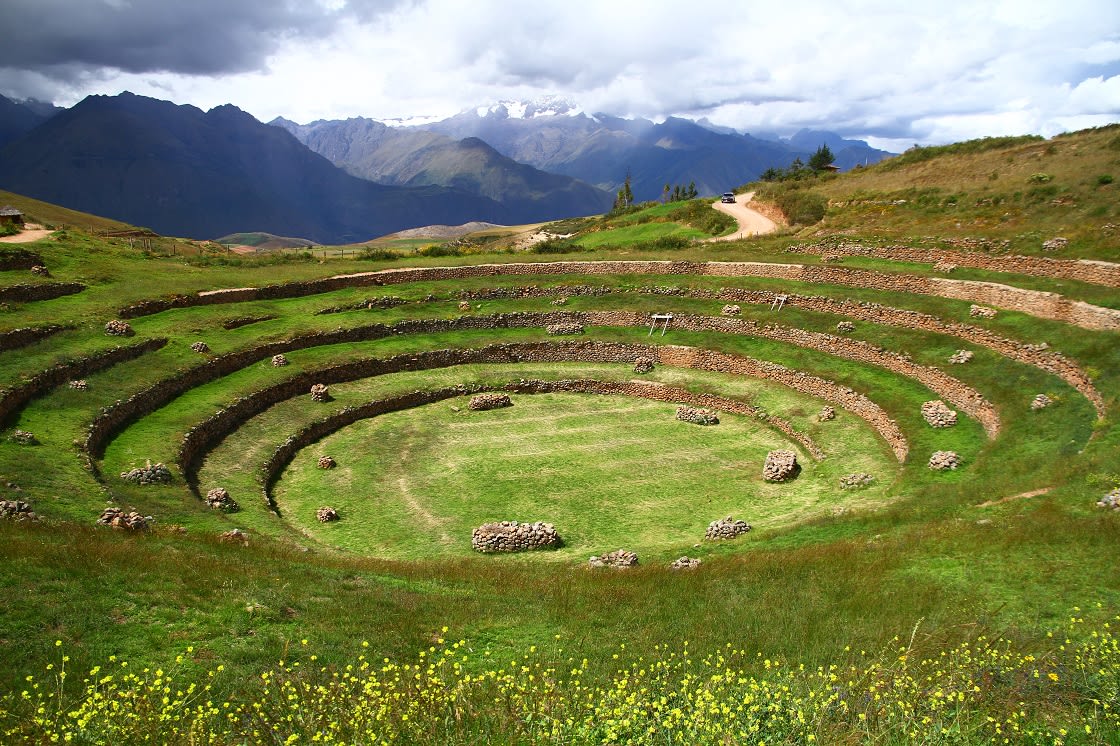
Just 50 kilometers from the city of Cusco, Peru sit the archaeological sites of Moray & Maras Salt Mines, a duo of rare Inca ruins that remain two of the most intriguing points of interest in the entire Sacred Valley of the Incas. The Inca ruins of Moray (Muray in Quechua) are particularly unusual, with a unique layout of enormous concentric circular depressions and still-unknown purpose.
To the east lies the village of Maras, known for its striking salt evaporation ponds, which have remained in use since pre-Inca times. Easy to access from Cusco by car, bike, or even hiking, Maras and Moray have a wealth of sights to offer any traveler. Read on for the best time to visit, how to get there, and why you should include a moray and maras salt mines tour to your time in Cusco, Peru!

Aerial View Of Moray, Archeological Site
Moray is easily identifiable in photos by its layout, visible even from the sky. It can best be described as a set of concentric circular depressions in the earth, which get progressively smaller as they move deeper into the ground (the deepest is 30 meters/98 feet below ground level). These depressions are terraced, and have a sophisticated irrigation system like many other Inca sites.
While we still do not know the purpose of these depressed terraces, their depth, design and orientation with respect to the wind and sun create a drastic temperature difference between every level, leading us to believe that they were used for agricultural experiments in which the Inca could study the effects of different climate conditions on crops (the temperature difference from top to bottom is as much as 15 degrees Celsius/27 degrees Fahrenheit). The microclimatic effect they created would have made it possible for them to study the domestication, acclimatization and hybridization of wild vegetable species that were adapted for human consumption.
Recently, erosion to the structure has been a concern, as atypical levels of precipitation during recent rainy seasons have caused permanent damage to the ruins of Moray. Temporary assistive structures have been built to support the ruins, but its future as a main tourist destination in Cusco is unknown.

Touring In Maras Salt Mines, Cusco Peru
Maras, a town in itself, is primarily known for its salt evaporation ponds. Since pre-Inca times, Maras has collected salt in the ponds by evaporating the salty water that emerges from a local underwater stream. The water naturally emerges from a spring, where it is then directed into a complex system of channels that sends it down into the several hundred ancient terraced ponds.
Each of the polygon-shaped ponds is less than 4 meters (12 feet) square, and no more than 30 centimeters deep. Workers carefully monitor the flow of water and maintenance of water channels between ponds, working closely together to remove the salt crystals that accumulate as the water evaporates under the warm Cusco sun.
Traditionally, the salt mines have been available to anyone wishing to harvest it, so long as they are members of the community. Larger ponds are given to larger families, and the newest members are given ponds further from the neighborhood.

Mountain Biking Tour to Maras & Moray
There are many options for accessing Maras & Moray from the city of Cusco (or other major destinations within the Sacred Valley). Most tourists arrive by car, usually as part of a larger Sacred Valley day tour or by hiring a driver for the day. A guided tour is recommended to fully understand the history and significance of the sights you’ll see, however it is a very accessible site for seeing yourself as well.
Maras & Moray are conveniently combined with a trip to Ollantaytambo, as you’ll drive right past Moray & Maras on the way there and back.
By Car:
You can access Moray & Moras from Cusco in just over an hour by car. It is possible to rent and drive your own car, hire a driver (taxi or van), or hire a driver/tour guide. If you plan to rent a car, your hotel can connect you with any of the car rental agencies, many you’ll recognize from back home. You can grab a taxi on the streets or have your hotel call one. If you prefer to hire a driver/tour guide or take a full tour, make sure to go through a reputable agency. If you do plan to do a tour, it’s very worthwhile to combine this visit with a trip to other Sacred Valley sites.
By Public Transportation:
If you plan to do it yourself and want to visit on the cheap, you can take public transportation from the city of Cusco. Shared taxis (known as “colectivos”) cost about 6-7 soles ($2USD), and the journey takes about 1 hour. Tell the driver “Maras”, and you will be let off at the Maras turn-off. Here, you can hire a driver at the turn-off to take you to both sites (any taxi is fine; usually costs 50 soles/ about $17USD per car). The downside here is that it can be challenging to find a seat on the colectivo on the return route to Cusco. You’ll have to wait until one passing has available seats, which will happen but may take some time. Not ideal for those who don’t want the hassle, but very cheap for those who don’t mind!
By Bike:
For those of you looking for adventure, it is also possible to arrange a mountain bike tour from the city of Cusco to Moray & Maras. Several companies operate these, and they are suitable for beginners and up. Most bike tours do the 35 kilometer journey from Cusco to Moray & Maras and back in about 5 hours, passing through other small villages along the way.

Salt Mines In Maras, Sacred Valley – Peru
Any time of year is perfect to visit these sites, however the dry season is always the most popular time to visit Cusco as a whole (from April-October). The rainy season (November-March) is less crowded and often cheaper, however you risk certain activities being rained out.
If photography is a factor, we recommend visiting Maras & Moray in the first half of the day. By around 4pm, most of the salt ponds of Maras are in the shadows and photos do not come out as bright as they do in the morning hours. If you plan to combine Maras & Moray with a trip to Ollantaytambo, we recommend stopping here on your way to Ollantaytambo, versus the other way around.

Inca Ruins With Circular Shape Terraces in Moray
A visit to Moray & Maras from the city of Cusco can be done in half a day if you plan to go by car: allow one hour for transportation each way, and just a couple hours for the destinations themselves. Many do half-day tours to these spots in 4 hours round-trip. If you are biking, allow at least 5 hours.
As two of the most spectacular sights in all of Peru, don’t forget to include a Maras & Moray tour during your trip to Cusco and the Sacred Valley of the Incas. Bring your camera and see why these mysterious and unique destinations truly stand out from the other ruins in the area! Contact us for more information.
While Rainforest Cruises aim to provide accurate and up-to-date information, we make no representations as to the accuracy or completeness of any information herein or found by following any link on this site. Rainforest Cruises cannot and will not accept responsibility for any omissions or inaccuracies, or for any consequences arising therefrom, including any losses, injuries, or damages resulting from the display or use of this information.




